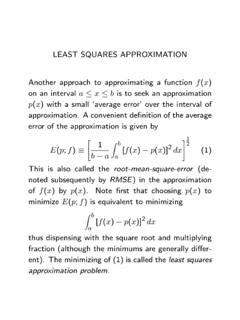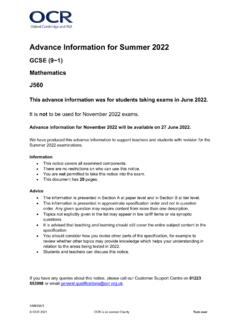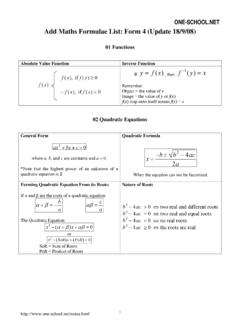Transcription of YEAR 11 GCSE MATHS REVISION CHECKLIST FOUNDATION …
1 YEAR 11 GCSE MATHS REVISION CHECKLIST . FOUNDATION TIER. TOPICS ARE CATEGORISED VIA MATHS STRANDS. NUMBER TOPICS. 1 Number Grade 1 to 4. J K L. Calculations Use priority of operations with positive and negative numbers. Simplify calculations by cancelling. Use inverse operations. Decimal numbers Round to a given number of decimal place. Multiply and divide decimal numbers. Place value Write decimal numbers of millions. Round to a given number of significant figures. Estimate answers to calculations. Use one calculation to find the answer to another. Factors and multiples Recognise 2-digit prime numbers. Find factors and multiples of numbers. Find common factors and common multiples of two numbers. Find the HCF and LCM of two numbers by listing. Squares, cubes and roots Find square roots and cube roots. Recognise powers of 2, 3, 4 and 5. Understand surd notation on a calculator.
2 Index notation Find square roots and cube roots. Recognise powers of 2, 3, 4 and 5. Understand surd notation on a calculator. Prime factors Write a number as the product of its prime factors. Use prime factor decomposition and Venn diagrams to find the HCF and LCM. 4 Fractions and percentages Grade 2 to 4. J K L. Working with fractions Compare fractions. Add and subtract fractions. Use fractions to solve problems. Operations with fractions Find a fraction of a quantity or measurement. Use fractions to solve problems. Multiplying fractions Multiply whole numbers, fractions and mixed numbers. Simplify calculations by cancelling. Dividing fractions Divide a whole number by a fraction. Divide a fraction by a whole number or a fraction. Fractions and decimals Convert fractions to decimals and vice versa. Use decimals to find quantities. Write one number as a fraction of another.
3 Fractions and percentages Convert percentages to fractions and vice versa. Write one number as a percentage of another. Calculating percentages 1 Convert percentages to decimals and vice versa. Find a percentage of a quantity. Use percentages to solve problems. Calculate simple interest. Calculating percentages 2 Calculate percentage increases and decreases. Use percentages in real-life situations. Calculate VAT (value added tax). 18 Fractions, indices and standard Grade 3 to 5. form J K L. Multiplying and dividing fractions Multiply and divide mixed numbers and fractions. The laws of indices To know and use the laws of indices. Writing large numbers in standard Write large numbers in standard form. form Convert large numbers from standard form into ordinary numbers. Writing small numbers in standard Write small numbers in standard form. form Convert numbers from standard form with negative powers of ordinary numbers Calculating with standard form To multiply and divide numbers in standard form.
4 To add and subtract numbers in standard form. ALGEBRA TOPICS. 2 Algebra Grade 2 to 4. J K L. Algebraic expressions Use correct algebraic notation. Write and simplify expressions. Simplifying expressions Use the index laws. Multiply and divide expressions. Substitution Substitute numbers into expressions. Formulae Recognise the difference between a formula and an expression. Substitute numbers into a simple formula. Expanding brackets Expand brackets. Simplify expressions with brackets. Substitute numbers into expressions with brackets and powers. Factorising Recognise factors of algebraic terms. Factorise algebraic expressions. Use the identity symbol and the not equals symbol . Using expressions and formulae Write expressions and simple formulae to solve problems. Use MATHS and science formulae. 5 Equations, inequalities and Grade 2 to 4. sequences J K L.
5 Solving equations 1 Understand and use inverse equations. Rearrange simple linear equations. Solve simple linear equations. Solving equations 2 Solve two-step equations. Solving equations with brackets Solve linear equations with brackets. Solve equations with unknowns on both sides. Introducing inequalities Use correct notation to show inclusive and exclusive inequalities. Solve simple linear inequalities. Write down whole numbers which satisfy an inequality. Represent inequalities on a number line. More inequalities Solve two-sided inequalities. More formulae Substitute values into formulae and solve equations. Change the subject of a formula. Know the difference between an expression, an equation, a formula and an identity. Generating sequences Recognise and extend sequences. Using the nth term of a sequence Use the nth term to generate terms of a sequence.
6 Find the nth term of an arithmetic sequence. 9 Graphs Grade 1 to 5. J K L. Coordinates Find the midpoint of a line segment. Recognise, name and plot straight-line graphs parallel to the axes. linear graphs Generate and plot coordinates from a rule. Plot straight-line graphs from tables of values. Draw graphs to represent relationships. Gradient Find the gradient of a line. Identify and interpret the gradient from an equation. Understand that parallel lines have the same gradient. y = mx + c Understand what m and c represent in y = mx + c. Find the equations of straight-line graphs. Sketch graphs given the values of m and c. Real-life graphs Draw and interpret graphs from real data. Distance-time graphs Use distance time graphs to solve problems. Draw distance time graphs. Interpret rate of change graphs. More real-life graphs Draw and interpret a range of graphs.
7 Understand when predictions are reliable. 16 quadratic equations and graphs Grade 3 to 5. J K L. Expanding double brackets Multiply double brackets. Recognise quadratic expressions. Square single brackets. Plotting quadratic graphs Plot graphs of quadratic functions. Recognise a quadratic function. Use quadratic graphs to solve problems. Using quadratic graphs Solve quadratic equations ax^2 + bx + c = 0 using a graph. Solve quadratic equations ax^2 + bx + c = k Using a graph. Factorising quadratic expressions Factorise quadratic expressions ax^2 + bx + c where a = 1. Solving quadratic equations Solve quadratic equations ax^2 + bx + c = 0 by factorising. algebraically 20 More algebra Grade 2 to 5. J K L. Graphs of cubic and reciprocal Draw and interpret graphs of cubic functions. functions Draw and interpret graphs of y = 1/x. Non- linear graphs Draw and interpret non- linear graphs to solve problems.
8 Solving simultaneous equations Solve simultaneous equations by drawing a graph. graphically Write and solve simultaneous equations. Solving simultaneous equations Solve simultaneous equations algebraically. algebraically Rearranging formulae Change the subject of a formula. Proof Identify expressions, equations, formulae and identities. Prove results using algebra. GEOMETRY TOPICS. 6 Angles Grade 2 to 5. J K L. Properties of shapes Solve geometric problems using side and angle properties of quadrilaterals. Identify congruent shapes. Angles in parallel lines Understand and use the angle properties of parallel lines. Find missing angles using corresponding and alternate angles. Angles in triangles Solve angle problems in triangles. Understand angle proofs about triangles. Exterior and interior angles Calculate the interior and exterior angles of regular polygons.
9 More exterior and interior angles Calculate the interior and exterior angles of polygons. Explain why some polygons fit together and some others do not Geometrical patterns Solve angle problems using equations. Solve geometrical problems showing reasoning. 8 Perimeter, area and volume 1 Grade 2 to 5. J K L. Rectangles, parallelograms and Calculate the perimeter and area of rectangles, triangles parallelograms and triangles. Estimate lengths, areas and costs. Calculate a missing length, given the area. Trapezia and changing units Calculate the area and perimeter of trapezia. Find the height of a trapezium given its area. Convert between area measures. Area of compound shapes Calculate the perimeter and area of shapes made from triangles and rectangles. Calculate areas in hectares, and convert between ha and m^2. Surface area of 3D solids Calculate the surface area of a cuboid.
10 Calculate the surface area of a prism. Volume of prisms Calculate the volume of a cuboid. Calculate the volume of a prism. More volume and surface area Solve problems involving surface area and volume. Convert between measures of volume. 10 Transformations Grade 2 to 4. J K L. Translation Translate a shape on a coordinate grid. Use a column vector to describe a translation. Reflection Draw a reflection of a shape in a mirror line. Draw reflections on a coordinate grid. Describe reflections on a coordinate grid. Rotation Rotate a shape on a coordinate grid. Describe a rotation. Enlargement Enlarge a shape by a scale factor. Enlarge a shape using a centre of enlargement. Describing enlargements Identify the scale factor of an enlargement. Find the centre of enlargement. Describe an enlargement. Combining transformations Transform shapes using more than one transformation.






